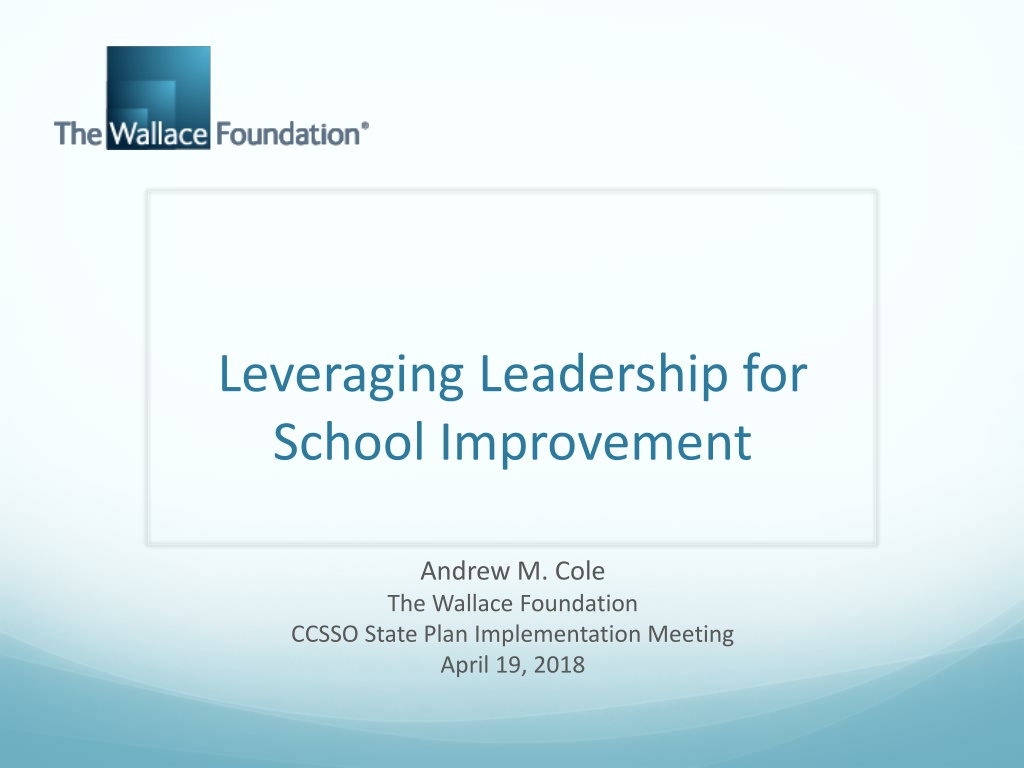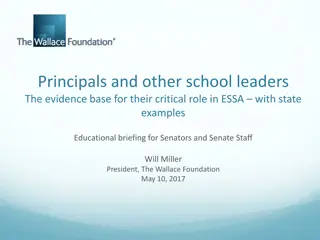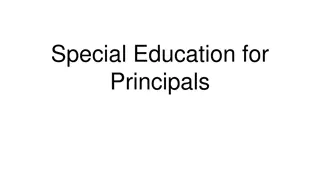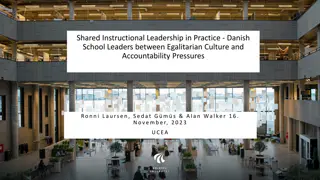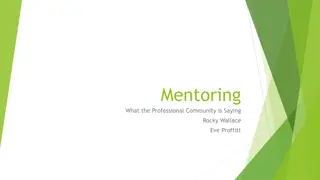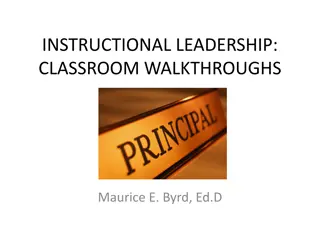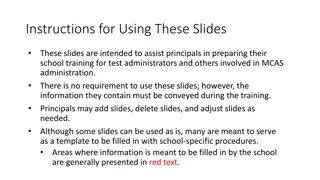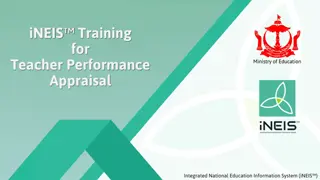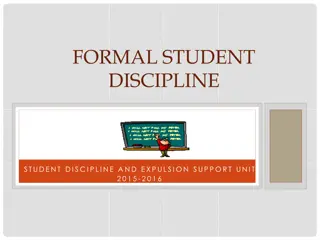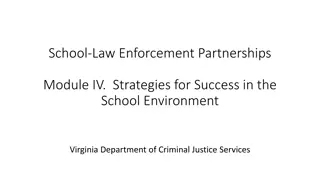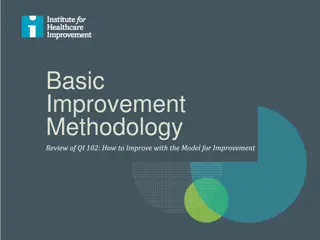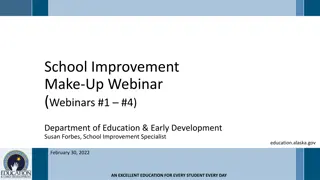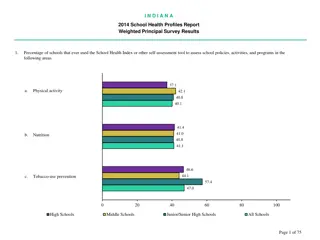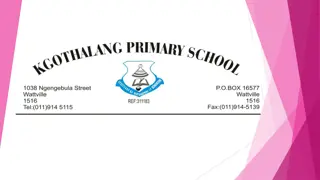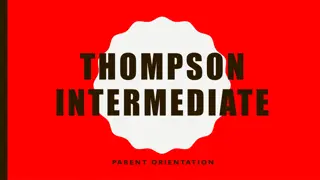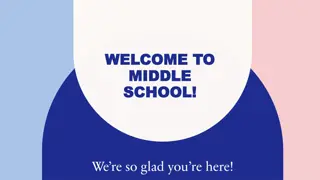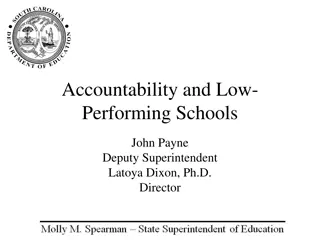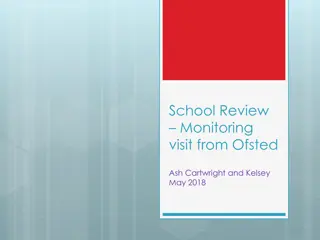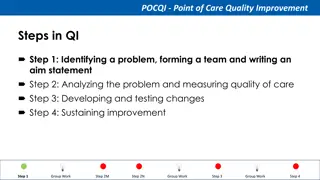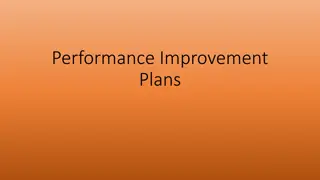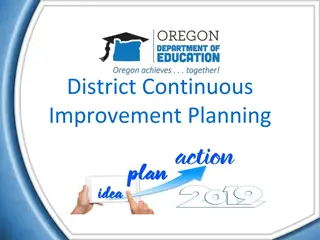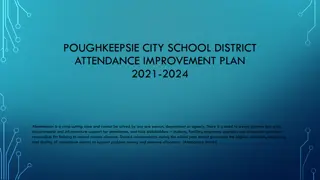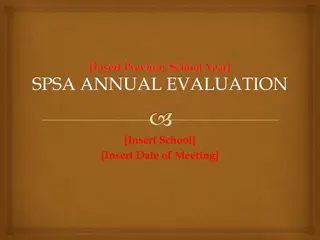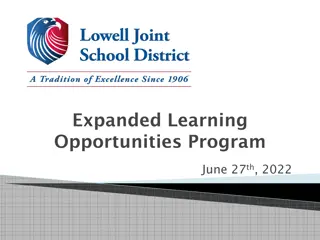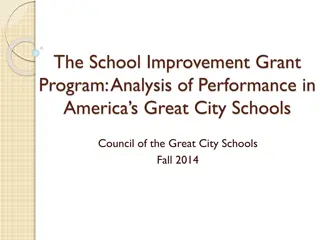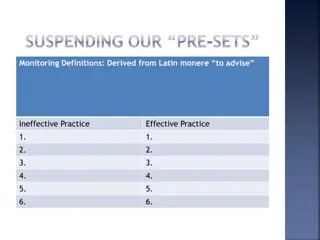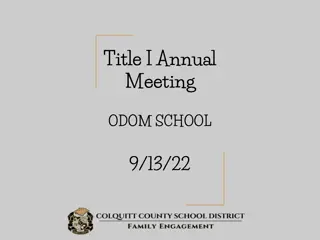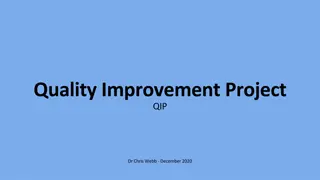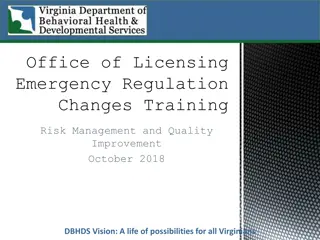Importance of Principals in School Improvement
Education leadership, particularly the role of principals, plays a crucial part in school improvement. Research shows that effective principals are key to enhancing student learning, teacher retention, and overall school performance. Their leadership is vital in driving positive outcomes and creating a conducive learning environment. Principals are essential in elevating struggling schools and retaining good teachers, thereby contributing significantly to the academic success of students.
Download Presentation

Please find below an Image/Link to download the presentation.
The content on the website is provided AS IS for your information and personal use only. It may not be sold, licensed, or shared on other websites without obtaining consent from the author. Download presentation by click this link. If you encounter any issues during the download, it is possible that the publisher has removed the file from their server.
E N D
Presentation Transcript
Leveraging Leadership for School Improvement Andrew M. Cole The Wallace Foundation CCSSO State Plan Implementation Meeting April 19, 2018
Todays discussion The role of education leadership in school improvement Growing recognition of the importance of leadership How states can leverage education leadership Implementation strategies Crystal Ball forecasting 2
Wide array of research on education leadership 3
30+ studies on school leadership meet ESSA evidence requirements 18 meet Tiers I through III evidence requirements Key conclusions: School leadership can be a powerful driver of improved education outcomes. Activities designed to improve school leadership demonstrate positive impact on student, teacher, and principal outcomes . Source: School Leadership Interventions Under the Every Student Succeeds Act Evidence Review, Rebecca Herman, et al, RAND, 2016 4
Principals are key to student learning Principals are second only to classroom instruction among all school-related factors that contribute to what students learn at school. -- How Leadership Influences Student Learning, Kenneth Leithwood, et al, University of Minnesota, University of Toronto, 2004 Principals are multipliers of effective teaching. -- Developing Excellent School Principals to Advance Teaching and Learning: Considerations for State Policy, Paul Manna, The Wallace Foundation, 2015 5
Principals are key to retaining good teachers Teacher turnover is lower in schools led by high-quality principals . Research further indicates that principal turnover leads to lower teacher retention and lower gains for students. -- School Leadership Interventions Under the Every Student Succeeds Act: Evidence Review, Rebecca Herman, et al, RAND, 2016 Principal effectiveness is associated with greater teacher satisfaction and a lower probability that the teacher leaves the school within a year. Moreover, the positive impacts of principal effectiveness on these teacher outcomes are even greater in disadvantaged schools. -- Can Good Principals Keep Teachers in Disadvantaged Schools? Linking Principal Effectiveness to Teacher Satisfaction and Turnover in Hard-to-Staff Environments, Jason A. Grissom, Teachers College Record, 2011 6
Principals are critical to improving struggling schools there are virtually no documented instances of troubled schools being turned around without intervention by a powerful leader. Many other factors may contribute to such turnarounds, but leadership is the catalyst. There seems little doubt that both district and school leadership provides a critical bridge between most educational-reform initiatives, and having those reforms make a genuine difference for all students. -- How Leadership Influences Student Learning, Kenneth Leithwood, et al, University of Minnesota, University of Toronto, 2004 7
School leadership is important to state school improvement efforts Especially during the last five to ten years, states have pushed forward ambitious education initiatives that will be unlikely to succeed without principals actively leading the work on the ground. -- Developing Excellent School Principals to Advance Teaching and Learning, Paul Manna, 2015 8
State of the Principalship 50% of principals leave by the end of their third year and 70% after five years Numbers are even higher in high-need schools, approximately 28% leaving each year Burnout from the overwhelming demands of the job, lack of decision-making authority, and isolation all contribute to this turnover Constant churn of principals has significant costs to students. Schools that lost principals were more likely to see a drop in student academic performance in the subsequent year. 9
And Also It takes an average of five years to put a vision in place, improve the teaching staff and fully implement policies and practices that positively impact the school s performance There is an empirical link between school leadership and improved student achievement High-quality principals hire better teachers and then hold on to them. School Leaders Network, 2014 Building a Principal Pipelines. The Wallace Foundation 10
The evolution of initiatives in education leadership 2014-2019 2011-2017 Principal Pipeline Initiative 2000-2010 Principal Supervisor Initiative First Generation Lessons Lessons 15 states; 15 districts 6 districts 8 districts Emerging Question: Emerging Question: Ifan urban district and its principal training programs provide large numbers of talented, aspiring principals with the right pre-service training and on-the-job evaluation and supports, will the result be a pipeline of principals able to improve teaching quality and student achievement, especially in schools with the greatest needs? If principal supervisors in urban districts shift from overseeing compliance to shaping principals instructional leadership capabilities and if they (both incumbents and aspirants) are provided with the right training, support and number of principals to supervise, would this improve the effectiveness of the principals with whom they work? 11
Principal pipelines benefit both districts and new principals The benefits for both districts and new principals are substantial Leader standards are important Leader evaluation systems seen as fair Mentors and principal supervisors most valued supports among novice principals Districts can do it Source: The Principal Pipeline Initiative in Action, Building a Stronger Principalship Vol 5, Brenda Turnbull, et al, Policy Studies Associates, 2016 12
Putting it all together: The Principal Pipeline High- quality aspiring leader preparation programs Evaluation and on- the-job support Leader standards Selective hiring 13
Principal pipelines are cost effective Because of leaders influence on schools, efforts to improve their recruitment, training, evaluation and ongoing development should be considered highly cost-effective approaches to successful school improvement. How Leadership Influences Student Learning, Kenneth Leithwood, et al, University of Minnesota, University of Toronto, 2004 New RAND study finds principal pipelines are affordable Pipelines are 0.4% of annual district budgets, according to study of six districts Minimal cost for two quick wins leader standards and selective hiring Coaching/Mentoring: Average cost $1,500 per principal -- Source: What it Takes to Operate and Maintain Principal Pipelines, Julia H. Kaufman, et al, RAND, 2017 14
Principal Pipeline Districts Denver, Colorado New York City, New York Charlotte Mecklenburg, North Carolina Prince Georges County, Maryland Gwinnett County, Georgia Hillsborough County, Florida 15
Principal supervisors play an important role in supporting principals Principals need support from principal supervisors, including relevant evaluation, in order to maximize their impact A focus on strengthening teaching and learning is crucial Representative survey of principals nationwide finds principals value their supervision and mentoring more when it s focused on instruction 86% of principals in six urban districts who were advised to improve received support to do so from their supervisors Source: Support for Instructional Leadership, RAND, 2016; and Evaluating and Supporting Principals, Building a Stronger Principalship, Volume 4,Policy Studies Associates, 2016 16
One position, many names CGCS Report
Principal Supervisors are Critical to Principal Performance Yet Position definition varies from district to district Hiring criteria can be vague Those in the position have little experience or training for the job The number of principals supervised prevents a sharp focus on principal performance Need to move from a compliance focus to an instructional focus building the principal performance 18
The Principal Supervisor Job is Critical to the Success of Principals Five Critical aspects of Principal Supervisor Support: Identify the training needs of the principals they supervise and provide this on an individualized basis; Manage learning networks among the principals with whom they work; Strengthen principals accountability by setting goals and objectives, supporting them in achieving them, and holding them accountable for the results; Strategically marshal resources and relationships in the community and serve as a buffer for principals with local groups; and Develop clear and shared visions, policies and expectations that focus on instructional improvement. 19
Four Goals of PSI Initiative Design, implement and test training and support to improve the performance of allprincipal supervisors in selected districts and develop methods to train and develop pools of successors; Assist districts in reducing principal supervisors span of control (i.e., the number of principals they supervise) and in planning central office redesign to support and sustain these changes; By looking across all the districts, develop emerging lessons about best ways to change the central office structure to support principal supervisors; and Assess the effectiveness and the effects of these activities across participating districts.
Principal Supervisor Initiative Sites Broward County Public Schools Cleveland Public Schools DeKalb County Public Schools Des Moines Public Schools Minneapolis Long Beach Tulsa Public Schools*(Lead District) District of Columbia Public Schools*(Lead District)
Landscape survey Districts dissatisfied; universities also want to improve Strong university-district partnerships are important, but rare Course of study does not match on-the- job realities States have authority to improve principal preparation, but are not using it as effectively as they could. Source: The Wallace Foundation, Improving University Principal Preparation Programs, 2016 22
What we hope to learn now How can university principal preparation programs working in partnership with high-needs school districts, exemplary preparation programs and the state improve their training so it reflects the evidence on how to best prepare effective principals? 23
The initiative design State policies 7 University programs TA, PLC Districts that employ graduates 6 partner providers Evaluation Conference to share lessons with non-grantees 24
University Principal Preparation Initiative Grantees Albany State University Florida Atlantic University North Carolina State University San Diego State University University of Connecticut Virginia State University Western Kentucky University 25
UPPI Elements Redesigned and implemented high Quality courses of Study with Practical on the job experiences with Partner Exemplar Programs States Receiving resources to review Principal Preparation Policies Putting into place Strong Robust University-District Partnerships 26
Practitioner tools help translate evidence into practice Sources: Principal Preparation Program Self-Assessment Toolkit, Education Development Center, 2009 and 2013; Model Principal Supervisor Standards, Council of Chief State School Officers, 2015. 27
Todays discussion The role of education leadership in school improvement Growing recognition of the importance of leadership How states can leverage education leadership 28
Growing recognition of the importance of school leadership The Education Commission of the States reports that 37 states introduced or passed legislation related to school leadership in 2017 New Leaders reports that all 50 states (plus DC and Puerto Rico) have included education leadership in their ESSA plans Some 46 states require of prioritize strategies to support school leadership or school improvement At least 10 states have updated their leader standards to be in accord with the 2015 national Professional Standards for Educational Leaders (PSEL) 29
Todays discussion The role of education leadership in school improvement Growing recognition of the importance of leadership How states can leverage leadership Implementation strategies Crystal Ball Forecasting 30
How states can leverage school leadership Develop policies and guidelines such as: Leader standards Accreditation of principal preparation programs Principal licensure standards Align program accreditation with principal licensure Develop statewide principal pipelines/leadership academies; empower districts to do so Disseminate effective practices throughout the state Gather and use accurate, timely and actionable data 31
34 states and D.C. working with Wallace and/or CCSSO on school leadership strategies Hawaii Wallace/CCSSO CCSSO 32
Using ESSA 24 states using Title II A optional setaside Other states using Title IIA or other Title II funding Examples of what they are funding: Principal training academies Mentoring Principal supervisors Principal pipelines Strategies to retain principals in high needs schools Professional learning communities 33
Crystal Ball Thoughts Challenges Opportunities Salary compression and its impact on Principal Hiring Stakeholder Engagement Principal Pipelines SEA capacity Robust Partnerships with Universities and other providers National Focus/Capacity Funding Redefinition of schools Equity Better support for principals through alignment Rural issues (poor and minority) Principal Supervisor development 34
For more information wallacefoundation.org 35
